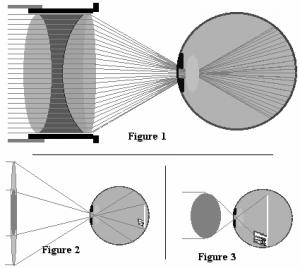Less is Better
Previous columns have described details of everything in a telescope except the eyepiece. Far from being the lowly tail end of a scope, an eyepiece is the scope's most complex optical subsystem. We are living in the golden age of eyepieces. We live in an age that is the optical equivalent of Cremona in the years that Stradivarius was crafting violins. The finest eyepieces ever made are appearing to the delight of professional and amateur astronomers. Precise combinations of specialty glass, exotic shapes and surfaces and completed with optical coatings designed for specific purpose make today's eyepieces far superior to those of just a few years ago.Eyepiece design is greatly constrained by the human eye (Figure 1). An eyepiece must "squeeze" the image so that it will pass through the small dark pupil. If the edge of the image doesn't pass through the pupil the image looses brightness, contrast and clarity. If the eyepiece squeezes too much, the rays carrying the image will come to a focus in front of the eye's lens blurring the image hopelessly.The angle at which the eyepiece presents the image to the eye determines the magnification that a particular telescope delivers. Relatively flat curved lenses bend light at a shallow angle resulting in low magnifications (Figure 2). Highly curved lenses bend light at a steep angle generating high magnifications (Figure 3). The distance from the lens to where all the light rays converge is the focal length. Combined with the focal length of the main objective mirror or lens, they determine the magnification. Our shortest focal length (strongest) eyepiece magnifies 800 diameters. Our longest focal length (weakest) eyepiece magnifies 72 diameters.You might think that we would favor our strongest eyepiece but we are many times more likely to use our weaker eyepieces. You might be even more surprised to learn that our weakest eyepiece cost three times the price of our strongest eyepiece. The high power has a close focal angle. This in turn means the lens must be very tiny or else most of the light will not pass through the eye's pupil. The actual lens is less than a quarter inch although the eyepiece holder is a 1.25" across by 1" long. To use our highest power lens you must bring your eye almost in contact with the eyepiece. If you let your eye drift slightly, the image will either go out of focus or disappear all together. In contrast our weakest lens is almost two inches across. It resides in a barrel 2" across by 4.5" long. This low power eyepiece is very forgiving. You can move you eye around and never lose the image. Looking through the high powered eyepiece is like looking through a soda straw while the low power is like looking through a ship's port hole.Higher magnifications come at a cost of restricted field of view. On our weakest eyepiece the entire Moon easily fits into the view. At the highest power, only a tiny part of the Moon (roughly a tenth of its diameter) can be seen at a time. While the high power may enhance the view of a single crater, it loses all the panorama.If the object is something which is faint like a nebula, using a high power means that only the light from a small part of the nebula is seen. When this dim light is magnified it becomes even fainter. Dim objects like the Horsehead Nebula can be seen in the low powered eyepiece but fade totally from view in the high powered eyepiece.High powers magnify not only the image, but all the imperfections caused by the turbulence of the Earth's atmosphere. An image of the Moon which seems crystal clear at lower powers may wobble and vibrate like it was made of Jell-O at high powers.Especially for viewers without computerized telescope pointing features, high powers have another unpleasant side effect. Since they examine very minute parts of the sky at a time, they must be pointed with very great care. Time and again we have had visitors with their telescopes with high magnification eyepieces unable to see such easy targets as Jupiter or Saturn. They are sure that they are doing something wrong. Well they are and the way to correct the problem is to switch to a low powered (and hence wider angled view) eyepiece.Whatever the merits of "less is better" may or may not be in other situations, it is undeniable the "less" magnification is often far "better" when it comes to viewing through an eyepiece.
- Author:
- Leslie Coleman
- Entry Date:
- Apr 1, 2003
- Published Under:
- Leslie Coleman's Columns


